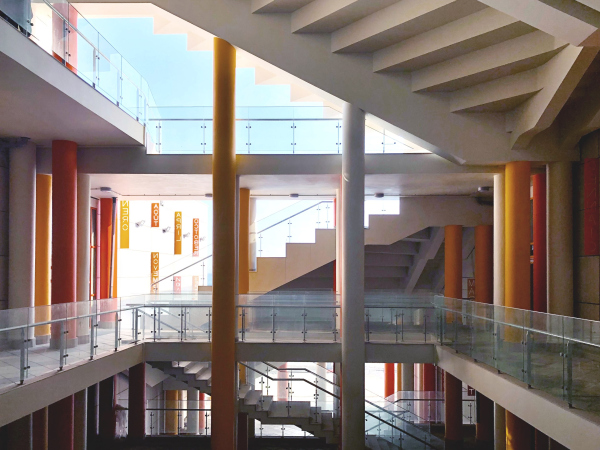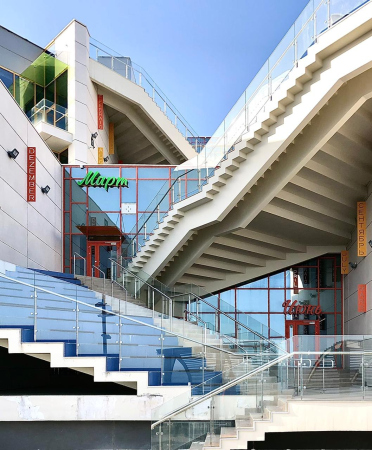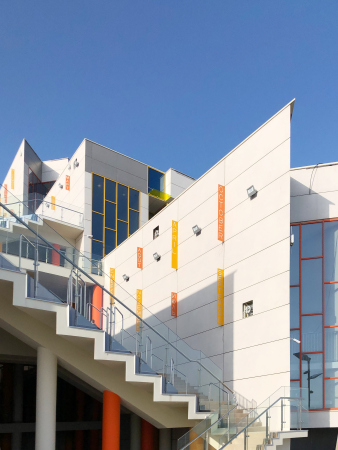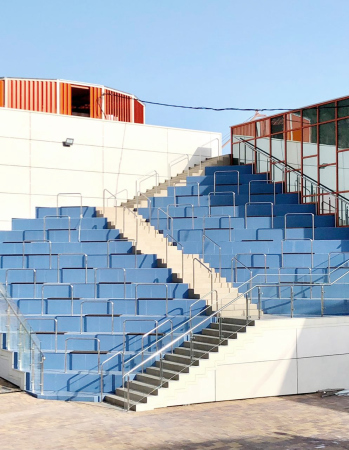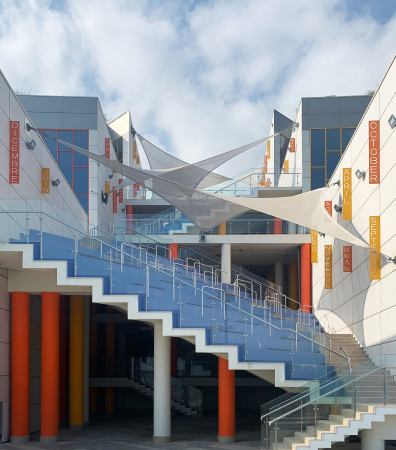The perfect world, so young and fair,
The perfect world without a care,
We’ll miss you so when you’re not there…
The perfect world without a care,
We’ll miss you so when you’re not there…
The “Artek” song
Artek began in 1925 as a small tent camp for children, and in 2016 it welcomed the 1.5Mth guest. After 2014, the camp was “reset”: its entire program changed, and now Artek is developed as a year-round “innovative venue for general and supplementary education, combined with fitness and recreation”; in accordance with the program, they also began renovating the buildings.
Over the years of its existence, Artek has grown to the size of five camps: Pribrezhny (“Seaside”), consisting of “Forest”, “Field”, “River”, and “Lake” divisions, Gorny (“Mountain”), consisting of “Diamond”, “Crystal”, “Amber”, “Sea”, “Cypress”, and “Azure” divisions. Quite soon, the new and the largest camp will appear, capable of housing up to a 1000 children per shift – “Solnechny”. It will become the first camp since 1995 to be built from scratch.
The international children′s center Artek. The Solnechny (Sunny) camp
The author of the master plan of the entire Artek and most of its buildings was the Soviet architect Anatoly Polyansky. The construction of this “pioneer camp”, cascading down to the sea in terraces, was something that he conceived still in the 1960’s in the southern part of the Artek grounds. However, they were unable to implement the master plan in its entirety back then. In the post-Soviet time, the Artek territory shrank in its southern part, giving way to private construction, a park, and a beach. As for the seaside fragment between “Cypress” and “Azure”, right across from the Adalar rocks, it lay undeveloped for half a century because of complex terrain, risk of landslides, and the absence of access roads.
In the 2000s, developing the program for developing Artek for the next decades, the leadership of the camp turned to the idea of developing the vacant land site lying between “Cypress” and “Azure”, which, among other things, would make it possible to make the territory more coherent from the Ayu-Dag of mountain in the north to the settlement of Gurzuf in the south. To achieve these tasks, they invited the project institute ARENA, which already took a significant part in the development of the camp: the architects worked on reconstructing and designing new buildings for the “Seaside” camp, designed “Artek Arena” on the site of the former Bonfire Square, as well as the educational center for the future “Sunny”.
The configuration of “Sunny”, and the principles of volumetric organization, recreate Polyansky’s ideas in the new location.
In order to neutralize the impact of soils, a cascade of retaining walls made of drilled piles was installed before construction.
The international children′s center Artek. The Solnechny (Sunny) camp
They definitely had a task of inscribing the building in the terrain, at the same time making it proportional to the surroundings and providing for the movement (sometimes Brownian) of pedestrian streams. One of the things that came in particularly handy for the institute was probably its experience in designing stadiums – no matter how you look at it, one thousand kids in one place is quite a figure.
The international children′s center Artek. The Solnechny (Sunny) camp
Copyright: © ARENA Project Institute
The City of the Sun
The more you examine the building, the more you think of utopian towns: possibly, it is the name of “Sunny” that brings such associations, or maybe the idea of a camp regimen, or in the architectural solutions that ultimately create a contained space. As we all know, “summer is a small life”, which is just enough to house a small utopia.
“Sunny” consists of four separately standing units built in accordance with the same principle: three levels two floors in each are arranged in a terraced fashion in such a way that the roof of the lower tiers is the terrace of the upper ones. The result is 12 blocks, which corresponds to 12 companies; this same figure lent itself for using the names of months for identifying and designing each of the blocks – they differ in colors and facade design. The top tier of the side buildings is almost half the width of the central ones, and thanks to this the terrace-like character is seen when you view the complex from the sea.
The international children′s center Artek. The Solnechny (Sunny) camp
Copyright: © ARENA Project Institute
Each room is a cell, a “little brick” in the overall volume of the building, which relates it to the specimens of Soviet architecture, and first of all to Yalta’s Druzhba resort. You can see here the same recognizable “scallops” of the rooms, which, on the other hand, are more of a plastique technique than a functional necessity: since the building is linear, and stands almost on the shoreline, the sea is already perfectly visible from each of its windows.
The international children′s center Artek. The Solnechny (Sunny) camp
Copyright: © ARENA Project Institute
Still, the architects try to make as much sea as possible: the south wall of each room is 100% glass, and has an exit to a small balcony, protected from the sunlight by an awning of colored polycarbonate. You can also shut yourself off from noisy neighbors on the balcony with a thick curtain. The “prongs” alternate with “Finnish” little balconies – a technique that makes it possible to diversify the buildings even more. The fragile crystalline volumes of stained glass are augmented by natural stone that allows the building to naturally fit in with the rocky slope.
The international children′s center Artek. The Solnechny (Sunny) camp
Copyright: © ARENA Project Institute
The international children′s center Artek. The Solnechny (Sunny) camp
Copyright: © ARENA Project Institute
Asher-esque Landscaping
The four buildings are interconnected by “membranes” – a sophisticated system of staircases and overpasses that serves as both vertical and horizontal communication core, as well as a place for events and recreation. This solution turns the building into an “island of diverging paths”: you can get from any point to any other by numerous paths, and the intertwined staircases and overpasses look like a labyrinth.
The international children′s center Artek. The Solnechny (Sunny) camp
Copyright: © ARENA Project Institute
In each of the “membranes”, the staircase takes you from the topmost tier to the seaside boulevard and the beach. At the level of the entrance groups, the staircases grow to the size of amphitheaters that are protected from the sunlight by “sails” resembling hovering birds. This way, each of the buildings gets its own venue for joint lineups, while the function of small yards is performed by green terraces.
The international children′s center Artek. The Solnechny (Sunny) camp
Copyright: © ARENA Project Institute
The upper level of the roof offers rather large venues for mass events, and it also has an educational function: the technical blocks are covered by bright-colored cylinders with lamellas, through which the kids can take a sneak peek at the engineering communications. The cylinders on the roof are probably also a reference to the “Friendship” restaurant.
Thus, “Sunny” as a whole, as well as each of its blocks, turn out to be self-sufficient. The territory of this “little city” provides enough space for everything: bedrooms, indoor and outdoor event venues, quiet corners for individual work and practice, as well as the sea splashing literally outside your door. The building itself becomes the object of research and cognition: ascending and descending the staircases every day, and going out to the balconies and terraces, one cannot but delve into its sophisticated architectural and engineering organization.
The international children′s center Artek. The Solnechny (Sunny) camp
Copyright: © ARENA Project Institute
The self-contained character of the building, however, does not limit the kids in getting diverse impressions because they have the whole enormous territory of Artek at their disposal. “Sunny” itself for example, will have a landmark of its own: the remains of the Christian basilica church of the VI century that were discovered and then buried again still in Soviet time. At the new stage of construction, these remains were cleared and conserved; they are planned to be integrated in the complex later on. The basilica will adorn the territory of the educational center that will complement “Sunny” and will be situated a little bit higher up the mountain. It will also include a cafeteria – once it is complete, the camp will be able to welcome new guests.
The international children′s center Artek. The Solnechny (Sunny) camp
Copyright: © ARENA Project Institute















